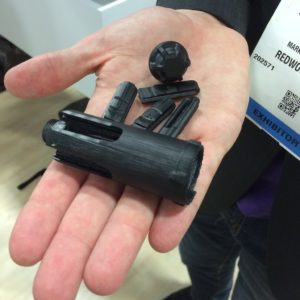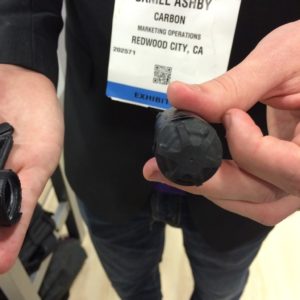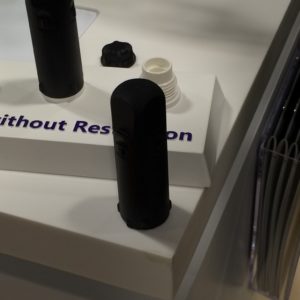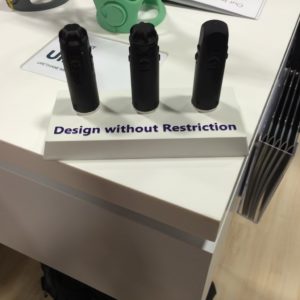 Last month at the Advanced Design & Manufacturing Expo (ADM Expo) in Cleveland, a major case study between Carbon, The Technology House (TTH), and Vitamix was announced that showcases how 3D printing can be the perfect fit for production workflows and result in real-world solutions as the technology presents an exciting digital future.
Last month at the Advanced Design & Manufacturing Expo (ADM Expo) in Cleveland, a major case study between Carbon, The Technology House (TTH), and Vitamix was announced that showcases how 3D printing can be the perfect fit for production workflows and result in real-world solutions as the technology presents an exciting digital future.
Normally when we hear the word “blender” in the 3D printing industry, our minds immediately turn to the popular 3D software. But partnering with Carbon and TTH allowed Vitamix, which manufactures high-end consumer and commercial kitchen blenders, to rethink the design and production of a pressurized rinsing nozzle for its commercial blender line.
 Carbon is no stranger to high-profile, collaborative AM solutions, and at the ADM Expo, Carbon’s Head of Production Partnerships Dana McCallum told us that this latest project was one the team was excited to have worked on. The original nozzle was made out of six injection-molded pieces, and Vitamix wanted to re-imagine the design and manufacturing of the piece so it would stand up better under commercial-grade applications that have constant exposure to harsh chemicals, high pressure, and hot temperatures.
Carbon is no stranger to high-profile, collaborative AM solutions, and at the ADM Expo, Carbon’s Head of Production Partnerships Dana McCallum told us that this latest project was one the team was excited to have worked on. The original nozzle was made out of six injection-molded pieces, and Vitamix wanted to re-imagine the design and manufacturing of the piece so it would stand up better under commercial-grade applications that have constant exposure to harsh chemicals, high pressure, and hot temperatures.
 TTH was the one to recommend 3D printing technology as a more efficient manufacturing method, but the design team decided to go all in and create a new, single-piece design for the nozzle. Enter Carbon’s proprietary Digital Light Synthesis (DLS) technology and durable Rigid Polyurethane (RPU) materials.
TTH was the one to recommend 3D printing technology as a more efficient manufacturing method, but the design team decided to go all in and create a new, single-piece design for the nozzle. Enter Carbon’s proprietary Digital Light Synthesis (DLS) technology and durable Rigid Polyurethane (RPU) materials.
DLS technology uses digital light projection to 3D print parts with consistent surface finishes, resolutions, and mechanical properties for the medical and consumer industries. According to Chadha, Carbon was the right choice for the project because of the nozzle redesign’s two main objectives – a new pattern that required fine, specific geometry so it could withstand high-speed jet water at high pressure and chemical cleaning products.Gurjeev Chadha, Carbon’s Head of Product Marketing, explained, “Carbon would be especially useful here because of the company’s ability to print complex designs as one part rather than multiple.”
 The company’s RPU material was used to make the part tough enough to hold up well in its harsh environment, and DLS technology made it possible to produce a part with excellent surface finish and complex channels and geometry. Not only that, but Carbon’s innovative 3D printing technology significantly reduced the product development time.
The company’s RPU material was used to make the part tough enough to hold up well in its harsh environment, and DLS technology made it possible to produce a part with excellent surface finish and complex channels and geometry. Not only that, but Carbon’s innovative 3D printing technology significantly reduced the product development time.
Chadha said, “Product engineers managed to iterate six to seven times on the nozzle design within a span of only four weeks while a single design iteration with the injection molded approach would have taken eight to 10 weeks.”
The new design features complex microfluidic channel structures and 300-micron holes in the nozzle. During testing, Vitamix discovered that the 3D printed version was more durable – maybe even ten times more – than the original, which was made with conventional injection molding. In addition, not only was the new nozzle design more durable than its predecessor, but it also used 30% less material and passed over 1.5 million cycle tests in the company’s demanding quality control process.
The 3D printed nozzle, down to just one component from a total of six, was able to be made at less cost, and take a more economical manufacturing approach by using less material, thanks to Carbon’s 3D printing technology. Because of this success, Vitamix is now thinking about how the technology could be applied to some of its other projects.- Vitamix nozzle at RAPID 2018 [Image: Sarah Saunders]
- [Images: Sarah Saunders]
“It’s hard not to think about how that component now interacts with other components. Perhaps this new tool and the new design freedom mindset can be leveraged across other existing parts,” Chadha said.
Discuss this and other 3D printing topics at 3DPrintBoard.com or share your thoughts in the Facebook comments below.
Subscribe to Our Email Newsletter
Stay up-to-date on all the latest news from the 3D printing industry and receive information and offers from third party vendors.
You May Also Like
Profiling a Construction 3D Printing Pioneer: US Army Corps of Engineers’ Megan Kreiger
The world of construction 3D printing is still so new that the true experts can probably be counted on two hands. Among them is Megan Kreiger, Portfolio Manager of Additive...
US Army Corps of Engineers Taps Lincoln Electric & Eaton for Largest 3D Printed US Civil Works Part
The Soo Locks sit on the US-Canadian border, enabling maritime travel between Lake Superior and Lake Huron, from which ships can reach the rest of the Great Lakes. Crafts carrying...
Construction 3D Printing CEO Reflects on Being Female in Construction
Natalie Wadley, CEO of ChangeMaker3D, could hear the words of her daughter sitting next to her resounding in her head. “Mum, MUM, you’ve won!” Wadley had just won the prestigious...
1Print to Commercialize 3D Printed Coastal Resilience Solutions
1Print, a company that specializes in deploying additive construction (AC) for infrastructure projects, has entered an agreement with the University of Miami (UM) to accelerate commercialization of the SEAHIVE shoreline...



































